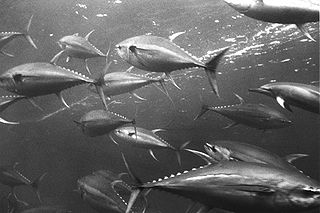
The mackerel, tuna, and bonito family, Scombridae, includes many of the most important and familiar food fishes. The family consists of 51 species in 15 genera and two subfamilies. All species are in the subfamily Scombrinae, except the butterfly kingfish, which is the sole member of subfamily Gasterochismatinae.
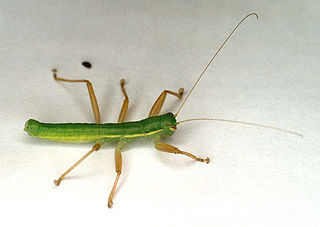
Mantophasmatidae is a family of carnivorous wingless insects within the monotypic order Mantophasmatodea, which was discovered in Africa in 2001. Recent evidence indicates a sister group relationship with Grylloblattidae, and Arillo and Engel have combined the two groups into a single order, Notoptera, with Grylloblattodea and Mantophasmatodea ranked as suborders.

The Apodiformes is an order, or taxonomic grouping, of birds which traditionally contained three living families—the Apodidae (swifts), the Hemiprocnidae (treeswifts), and the Trochilidae (hummingbirds); however, in the Sibley-Ahlquist taxonomy, this order is elevated to the superorder Apodimorphae, in which hummingbirds are separated into a new order, the Trochiliformes. With nearly 450 species identified to date, it is the most diverse order of birds after the Passeriformes.

Opisthocomidae is a family of birds, the only named family within the order Opisthocomiformes. The only living representative is the hoatzin which lives in the Amazon and the Orinoco delta in South America. Several fossil species have been identified, including one from Africa and one from Europe.

The Lacertidae are the family of the wall lizards, true lizards, or sometimes simply lacertas, which are native to Afro-Eurasia. It is a diverse family with at about 360 species in 39 genera. They represent the dominant group of reptiles found in Europe.
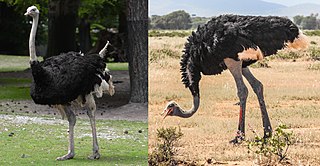
Ostriches are large flightless birds. Two living species are recognised, the common ostrich, native to large areas of sub-Saharan Africa, and the Somali ostrich, native to the Horn of Africa.
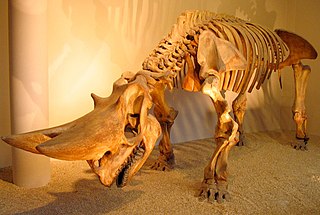
Embrithopoda ("heavy-footed") is an order of extinct mammals known from Asia, Africa and Eastern Europe. Most of the embrithopod genera are known exclusively from jaws and teeth dated from the late Paleocene to the late Eocene; however, the order is best known from its terminal member, the elephantine Arsinoitherium.

Megistotherium is an extinct genus of hyaenodont belonging to the family Hyainailouridae that lived in Africa.

Dissopsalis is a genus of teratodontine hyaenodonts of the tribe Dissopsalini. The older species, D. pyroclasticus, lived in Kenya during the middle Miocene, while the type species, D. carnifex, lived in Pakistan and India during the middle to late Miocene.

Atelestidae is a family of flies in the superfamily Empidoidea. The four genera were placed in a separate family in 1983; they were formerly either in Platypezidae or considered incertae sedis. While they are doubtless the most basal of the living Empidoidea, the monophyly of the family is not fully proven. The genus Nemedina seems to represent a most ancient lineage among the entire superfamily, while Meghyperus is probably not monophyletic in its present delimitation, and it is liable to be split up eventually, with some species being placed elsewhere. In 2010, the genus Alavesia, previously only known from Cretaceous fossils, was found alive in Namibia, subsequent species were also described from Brazil.

Cylindracanthus is an extinct, enigmatic genus of marine ray-finned fish with fossils known throughout North America, Europe, Asia and Africa from the Late Cretaceous to the late Eocene, with potential Oligocene records and a possible Miocene record also known. It is exclusively known from its distinctive partial remains, which are long cylindrical bony spines that are usually considered rostrum fragments, as well as some associated teeth. These spines are abundant & widespread throughout this timespan, and are useful indicators of a nearshore marine environment, but the taxonomic identity of the fish is still highly uncertain and debated.

Trionyx is a genus of softshell turtles belonging to the family Trionychidae. In the past many species in the family were classified in this genus, but today T. triunguis, the African or Nile softshell turtle, is the only extant softshell still classified as Trionyx. The other species still assigned to this genus are only known from fossils. T. triunguis is a relatively large, aquatic piscivore.
Notnamaia is a genus of primates that lived in Africa during the early middle Eocene. It contains one species, N. bogenfelsi. Its describers considered it to be an early simian, but other researchers have generally placed it within Strepsirrhini, possibly aligned with the djebelemurids or caenopithecines.

Falcatodon is an extinct genus of hyainailourid hyaenodonts of the subfamily Hyainailourinae, from the Early Oligocene (Rupelian) of the Faiyum Oasis depression in Egypt.
Sectisodon is an extinct genus of hyainailourid hyaenodont mammal of the subfamily Hyainailourinae from early Oligocene to early Miocene deposits in Egypt and Uganda.

Dissopsalini is an extinct tribe of teratodontid hyaenodonts. Fossil remains of these mammals are known from early to late Miocene deposits in Asia and Africa.

Hyainailourinae ("hyena-cats") is an extinct subfamily of hyainailourid hyaenodonts that lived in Africa, Asia, North America and Europe from the middle Eocene to middle Miocene. They appeared in Africa about 47.8 Ma ago and soon after spread as far as East Asia.
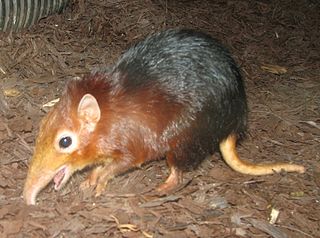
Eorhynchocyon is an extinct mammal genus from the macroscelidid superfamily.
Damarachloris is an extinct genus of chrysochlorid that inhabited Namibia during the Eocene epoch. It contains a single species, D. primaevus.













